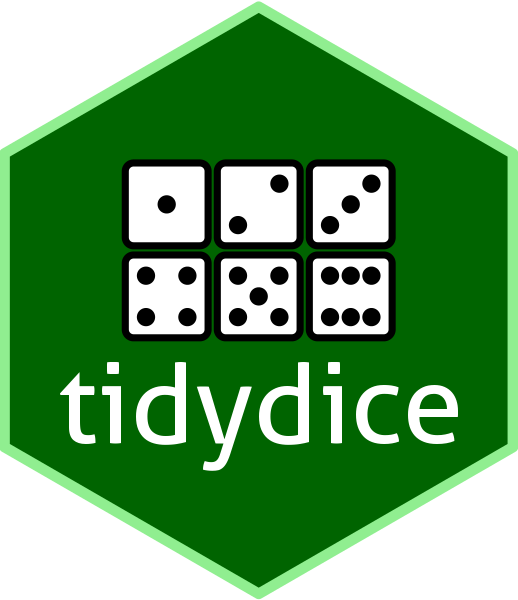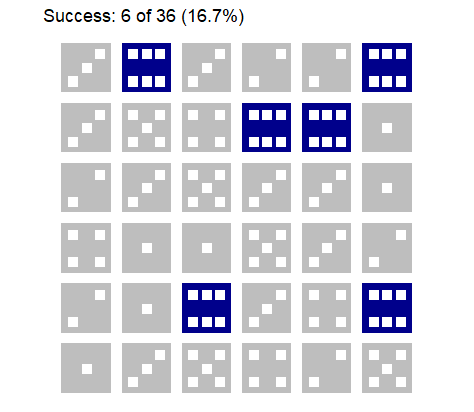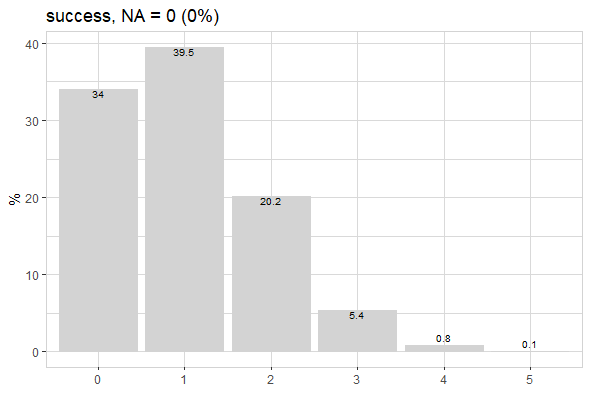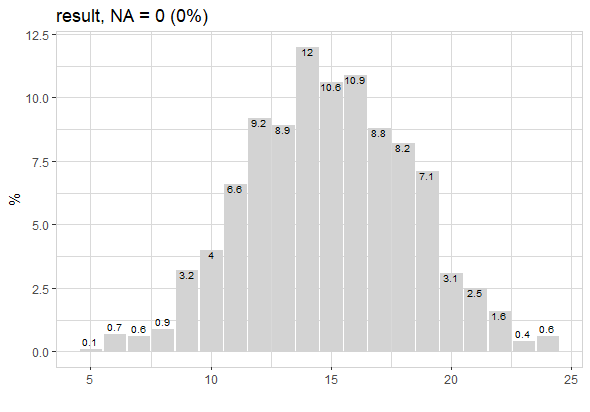Let's roll dice!
{tidydice} 1.0.0 is here!
Why {tidydice}

A basic understanding of probability and statistics is crucial for data understanding. A great way to teach probability and statistics is to start with an experiment, like rolling a dice or flipping a coin.
{tidydice} simulates rolling a dice and flipping a coin. Each experiment generates tidy data (tibble). Dice rolls and coin flips are simulated using sample(). The properties of the dice can be changed, like the number of sides. A coin flip is simulated using a two sided dice. Experiments can be combined with the pipe-operator.
Design
The default dice design is black/white with gold as highlight for a success.
To make it reproducible, use seed
# use package
library(tidydice)
# example: roll dice 6 times
roll_dice(times = 6, seed = 123) |>
plot_dice()

You can control the design of dice using plot_dice() arguments:
fill= fill color of dicefill_success= fill color of dice if result is a successpoint_color= color of pointsline_color= color of linesline_size= size of lines
roll_dice(times = 6, seed = 123) |>
plot_dice(fill = "darkgrey",
fill_success = "darkblue",
line_color = "white",
point_color = "white")

Repeat
We see 2 six. This is more than th expected value, which is 1. (A dice has 6 sides, so the probability of getting a six is 1/6)
Now let’s repeat this experiment 6 times
roll_dice(times = 6, rounds = 6, seed = 123) |>
plot_dice(fill = "darkgrey",
fill_success = "darkblue",
line_color = "white",
point_color = "white")

Now we get 6 six. This is excactly the expected value.
Aggregate
Lets increase rounds to 10 000. To see how many times we got a six in each round, use agg = TRUE
roll_dice(times = 6, rounds = 10000, agg = TRUE, seed = 123)
# A tibble: 10,000 × 4
experiment round times success
<int> <int> <int> <int>
1 1 1 6 2
2 1 2 6 2
3 1 3 6 0
4 1 4 6 0
5 1 5 6 2
6 1 6 6 0
7 1 7 6 0
8 1 8 6 1
9 1 9 6 0
10 1 10 6 1
# … with 9,990 more rows
We get a tibble, where each row represents one round.
Let’s use {explore} to visualise the result
roll_dice(times = 6, rounds = 10000, agg = TRUE, seed = 123) |>
explore(success)

Binomial Distribution
By repeating the experiment 10 000 times we already get pretty close to the Binomial Distribution:
binom_dice(times = 6)
# A tibble: 7 × 3
success p pct
<int> <dbl> <dbl>
1 0 0.335 33.5
2 1 0.402 40.2
3 2 0.201 20.1
4 3 0.0536 5.36
5 4 0.00804 0.804
6 5 0.000643 0.0643
7 6 0.0000214 0.00214
binom_dice(times = 6) |>
plot_binom(highlight = 3:6)

The chance to get 3 or more six is just 6.23%
Cheating
We can cheat by increasing the probability of getting a six from 1/6 (0.167) to 1/2 (0.5).
roll_dice(
times = 6,
prob = c(0.1,0.1,0.1,0.1,0.1,0.5),
seed = 123
) |> plot_dice()

Can this cheating be detected? 3 six is still in a normal range.
Let’s do an experiment!
roll_dice(times = 6, rounds = 10000, agg = TRUE) |>
roll_dice(
times = 6, rounds = 10000, agg = TRUE,
prob = c(0.1,0.1,0.1,0.1,0.1,0.5)) |>
explore(success, target = experiment)

The plot shows, that there is a high chance that the cheating will be detected, if we roll the dice multiple times. Because getting 4 or more six is very unlikely if there is no cheating.
Using Dice Formula
If you want to do more complex dice rolls, use roll_dice_formula() (many thanks to Giovanni Marco for contributing the code!)
roll_dice_formula(
dice_formula = "4d6", # 4 dice with 6 sides
success = 15:24, # success: sum between 15 and 24
seed = 123 # random seed to make it reproducible
)
# A tibble: 1 × 7
experiment dice_formula label round nr result success
<int> <chr> <chr> <int> <int> <dbl> <lgl>
1 1 4d6 4d6 1 1 18 TRUE
# 4 dice with 6 sides + 1 dice with 10 sides
# repeat 1000 times
roll_dice_formula(
dice_formula = "4d6+1d10",
rounds = 1000) |>
explore_bar(result, numeric = TRUE)

Other examples for dice_formula:
1d6= roll one 6-sided dice1d8= roll one 8-sided dice1d12= roll one 12-sided dice2d6= roll two 6-sided dice1d6e6= roll one 6-sided dice, explode dice on a 63d6kh2= roll three 6-sided dice, keep highest 2 rolls3d6kl2= roll three 6-sided dice, keep lowest 2 rolls4d6kh3e6= roll four 6-sided dice, keep highest 3 rolls, but explode on a 61d20+4= roll one 20-sided dice, and add 41d4+1d6= roll one 4-sided dice and one 6-sided dice, and sum the results
Weblinks
- {tidydice} on Github: https://github.com/rolkra/tidydice
- {explore} on Github: https://github.com/rolkra/explore